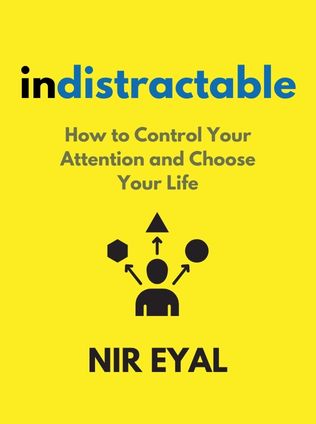
Indistractable
How to Control Your Attention and Choose Your Life
By Nir Eyal
Published 08/2019
About the Author
Nir Eyal, the author of Indistractable, is a renowned expert in behavioral design, focusing on how technology shapes our habits and behaviors. With a background in psychology and business, Eyal has dedicated his career to understanding the intricacies of human behavior, particularly in the context of technology's pervasive influence. His earlier work, Hooked: How to Build Habit-Forming Products, became a seminal guide for product designers aiming to create engaging products that users return to again and again. However, as Eyal's understanding deepened, he recognized the darker side of habit-forming technology—the potential for distraction and the erosion of focus. This realization led him to write Indistractable, a book that empowers individuals to reclaim their attention in a world designed to capture it.
Eyal's insights are grounded in rigorous research and practical experience, making him a thought leader in both the fields of psychology and technology. He frequently speaks at conferences and writes for major publications, sharing strategies for managing distractions and fostering productivity. Through his work, Eyal has become a leading advocate for a more mindful approach to technology, where users are not just consumers but active participants in shaping their digital environments.
Main Idea
The core message of Indistractable is that our actions are either leading us toward our goals or pulling us away from them. Eyal introduces the concepts of traction and distraction to describe these opposing forces. Traction refers to actions that move us closer to our aspirations, while distraction leads us away from them. In a world saturated with technology, achieving traction has become increasingly challenging. The constant barrage of notifications, emails, and social media updates creates an environment ripe for distraction.
Eyal argues that to regain control over our lives, we must become "indistractable." This state of being requires understanding the root causes of our distractions, both internal and external, and developing strategies to manage them. Eyal's approach is holistic, addressing the psychological, emotional, and environmental factors that contribute to distraction. By following his four-part model—controlling internal triggers, building a schedule around values, reducing external triggers, and creating precommitments—individuals can cultivate the focus needed to achieve their most important goals.
Table of Contents
- Control Your Internal Triggers
- Build Your Schedule Around Your Values
- Reduce External Triggers
- Create Precommitments
- Applying Indistractable Principles in Work, Home, and Relationships
Control Your Internal Triggers
At the foundation of Eyal’s indistractability model is the recognition that distractions often originate from within. Internal triggers—emotions like boredom, anxiety, or frustration—prompt us to seek relief in activities that offer immediate gratification but little long-term value. Eyal emphasizes that the first step to becoming indistractable is to gain control over these internal triggers. Rather than reacting impulsively to discomfort, we must learn to recognize it, understand its origins, and choose healthier ways to address it.
Eyal introduces three exercises to help manage internal triggers. The first exercise is self-reflection. When faced with the urge to engage in a distracting activity, Eyal advises pausing to ask, "What am I feeling right now? What discomfort am I trying to escape?" This simple act of self-inquiry can reveal underlying emotions that drive distractions. For example, you might discover that you turn to social media to escape feelings of loneliness or inadequacy. By acknowledging these emotions, you can begin to address them directly, rather than through avoidance.
In addition to reflection, Eyal suggests reframing the situation to make it more engaging. He argues that boredom and frustration often stem from a lack of challenge or novelty in our activities. By introducing elements of fun or competition, we can transform mundane tasks into opportunities for growth and discovery. For instance, if you find your work repetitive, try setting specific, measurable goals for improvement, or challenge yourself to complete tasks more efficiently. This shift in perspective can reduce the internal triggers that lead to distraction.
"Fun doesn’t always feel good—it often feels like challenge, discovery, or freedom from discomfort." - Nir Eyal
The final exercise involves rethinking your identity. Eyal challenges the notion that willpower is a finite resource, suggesting instead that it is a fluctuating emotion. He encourages readers to redefine themselves in ways that align with their goals. For example, by adopting the identity of someone who is "indistractable," you create a self-image that naturally guides your behavior. This identity shift is powerful because it influences not just your actions, but also your underlying beliefs about what you are capable of achieving.
Eyal’s approach to managing internal triggers is both practical and transformative. By cultivating self-awareness, reframing our experiences, and reshaping our identities, we can develop the resilience needed to stay focused in a world full of distractions. These techniques are not about suppressing emotions but about understanding and working with them in a constructive way.
Sign up for FREE and get access to 1,400+ books summaries.
You May Also Like
The Subtle Art of Not Giving a F*ck
A Counterintuitive Approach to Living a Good Life
By Mark MansonRich Dad Poor Dad
What the Rich Teach Their Kids About Money - That the Poor and Middle Class Do Not!
By Robert T. KiyosakiHow To Win Friends and Influence People
The All-Time Classic Manual Of People Skills
By Dale CarnegieFreakonomics
A Rogue Economist Explores the Hidden Side of Everything
By Steven D. Levitt and Stephen J. Dubner



















